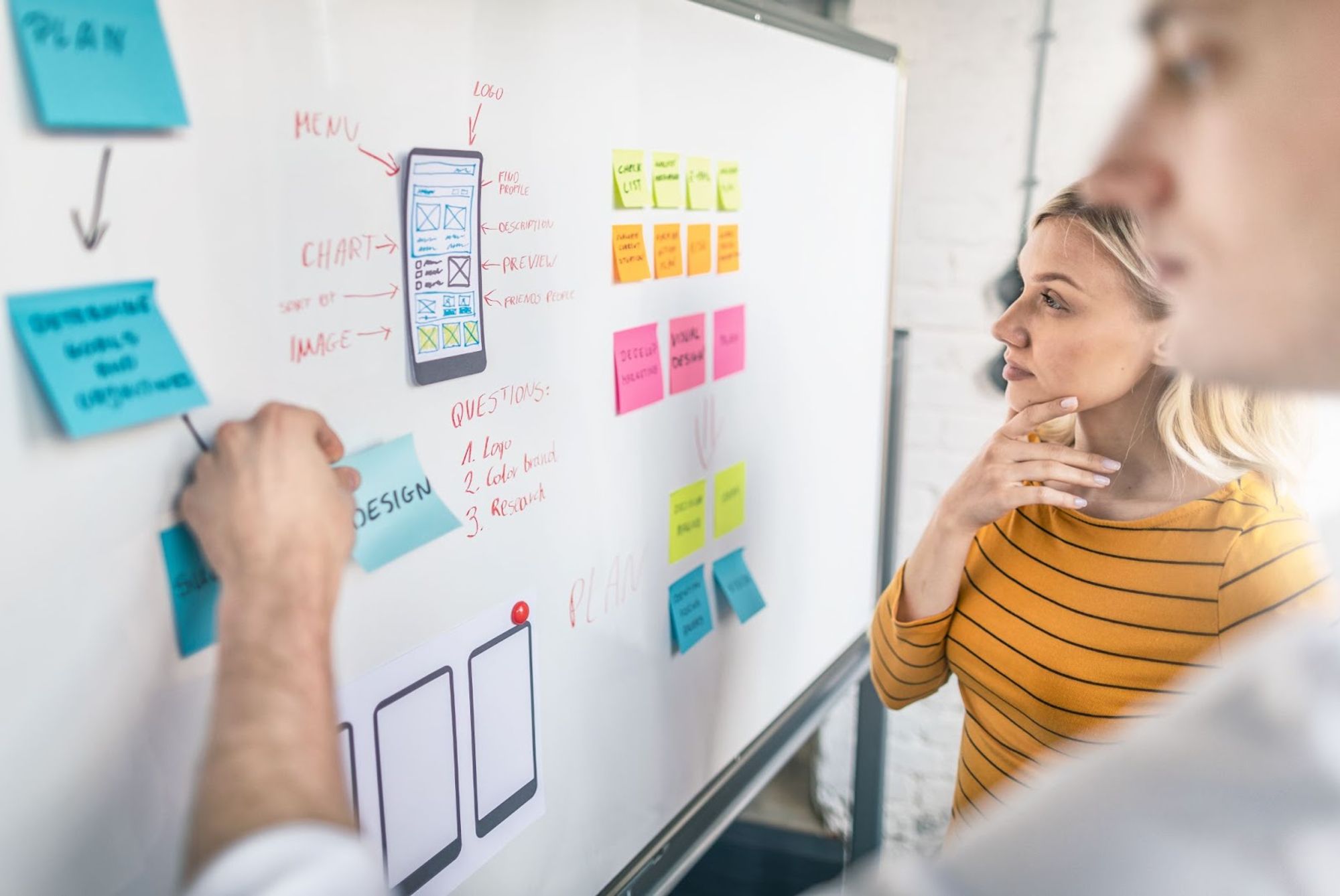Why Innovation Processes Are Key for Business Growth
March 17, 2022
Why Innovation Processes Are Key for Business Growth
An innovation process can improve product development, customer service, and beyond. Start making valuable changes with these strategies and tips.

In an always-connected world, embracing innovation is key to survival and growth.
Netflix, after all, was only a small company compared to video rental store Blockbuster. However, their embrace of digital delivery allowed them to acquire market dominance and make their rival’s business model obsolete.
In this article, we’ll consider:
- Five types of projects innovation processes are used for
- Three main innovation strategies
- How to get the best results from an innovation project
5 Main Types of Innovation Projects
Innovation processes use knowledge and ideas to create valuable changes in businesses. Take a look at these five types of innovation projects that can benefit from such a process.
1. Business Model Innovation
A business model is the plan a company uses to provide customers with its products and services profitably and at an appropriate cost.
The aim of this type of innovation process is to seek better, more efficient ways to deliver a business’s existing products to their markets using existing technologies.
On other occasions, companies use the process to determine whether new products and services will better meet customer needs and that may also open up brand new markets.
2. Business Process Innovation
Business processes are the steps required by a company to get their products and services to market.
This type of innovation process aims to find ways to streamline a company's working practices for greater efficiency without sacrificing the end-user quality of experience.
For example, if there is a 10% failure on products from an assembly line, business process innovation can help discover why the failure rate is so high and what can be done to reduce it.
3. Digital Business Model Innovation
In recent years, businesses have begun to incorporate artificial intelligence and machine learning in research and development, process automation, data-driven decision making, and more.
In the digital business model innovation process, companies consider how to leverage technology to improve their value proposition. A better value proposition may lead to new opportunities to upsell or charge a premium to customers.
4. Product Development Innovation
The product development innovation process focuses on bringing new, redesigned, or significantly better products and services to market.
Incremental innovation is the gradual development of improved features and functionality over time in smaller steps, rather like software patches.
The aim of disruptive innovation is to shake up the market so much so that a company’s new products, services, and solutions may replace current alternatives over time.
5. Customer Service Innovation
The likelihood of a customer buying from the same company repeatedly is often determined by how well they feel they are being treated and how quickly their concerns are addressed.
The customer service innovation process seeks to find ways to create stronger connections between companies and their customers through higher-quality interactions.
Results from this process could include a “knowledge base” on a company website answering existing users’ most frequently asked questions and a library of articles on smarter ways to use a product or service.
Top 3 Innovation Strategies

Innovation teams generally take one of the three following approaches to ideation, prototype creation, and product testing.
1. UX Design Process
Perhaps the world’s most famous designer, Steve Jobs, memorably said, “Design is not just what it looks like and feels like. Design is how it works.”
The UX design process can be characterized as coming up with what a company believes is the right idea first and continually modifying the prototype based on feedback until the desired outcome is achieved.
The goal of the research and development process involves changing the characteristics of the prototype based on feedback from user research and testing.
For example, Apple uses the UX process, and their product innovation focus is on design, functionality, form, features, and software. Many of their products, like the iPhone, were disruptive and radical innovations.
The iPhone changed:
- How users perceived how mobile phones should work (the iPhone doesn’t have a physical keyboard)
- What they could do (Apple created a way to systematically organize apps in the App store)
Customers and competitors adopted Apple's idea of what a phone should be in a very short time.
More examples: Companies using the UX process include Airbnb, Amazon, and Intuit.
Timeframe: Most companies budget three months for a UX project, although it can be condensed depending on business requirements.
2. Design Thinking
There are five stages in the design thinking innovation process. Instead of starting with the prototype of a product or service, the focus in design thinking starts with empathy.
Innovation team members put themselves in users' shoes to understand what they might think and feel about their situation, circumstance, or problem. The emphasis is on finding the root cause of a problem and not on the symptoms.
Following this "empathize" stage, "problem statements" are created for use in the "define" stage. These statements attempt to define the problem it is you need to solve.
In the next stage, "ideation", team members ask questions and challenge assumptions to drive teams beyond obvious solutions. No judgment is passed on ideas, and the goal is to generate as many possible solutions as possible.
Ideas are then selected to take to the "prototype" stage. The focus is on the viability, feasibility, and desirability of a potential solution. These prototypes (which can range from sketches to 3D printed models with moving parts) are then given to users for testing and feedback in the final "test" stage.
The process may go right back to the "empathize" stage if a new and previously unencountered user problem becomes evident later on. And promising prototypes often go back to "ideation" or "prototype" for further finessing.
Examples: Companies using design thinking include Tharsus, Qumodo, Immaterial, GE, Oral B, Nike, Starbucks, Bank of America, and Nordstrom.
Timeframe: There is no set time limit in which the design thinking process must take place.
3. Design Sprint
Created by Google, the design sprint innovation process borrows much from design thinking. Design sprints balance the interests and points of view of both the customer/end-user and the company.
The five traditional phases of the design sprint innovation process are:
- Understand: From a base of shared knowledge, team members discuss the problem from the perspective of the business, the user, the competition, and in relation to technology.
- Define: Following an evaluation of the insights from the first stage, the team sets the context of the exercise as well as the desired outcome measurable by signals, metrics, and goals.
- Sketch: This is the idea generation stage in design sprints. Each participant generates ideas looking for inspiration often from alternative or unusual sources of perspectives. Top ideas are then turned into a clear and easy-to-understand “Solution Sketch”, which is an expanded view of the solution that can use both words and visuals.
- Decide: At this stage, the final decision on which Sketch will be taken forward to the prototype stage is taken.
- Prototype: Prototypes are often not actual physical prototypes but documents detailing the characteristics of the concept of a proposed solution. From this document, a potential user would then provide their thoughts on what it would be like to use the product. This feedback shows the team what the end-user experience might be like and how to test to achieve the optimal results.
Not every company is Google and, as a result, many innovation practitioners, including Innoveto, have modified the design sprint process to help clients find solutions closer to their and their users' specific needs.
Examples: Companies using the design sprint process include Dropbox, Twitter, the New York Times, Facebook, Slack, Medium, and Uber.
Timeframe: Most design sprints conclude after 5 to 7 working days.
Top Tips for a Successful Innovation Process
Involve stakeholders in all innovation initiatives. In product development, for example, stakeholders are not only just people who use a product or service. They're also the people who work the raw materials, write the code, answer the phones to confused customers, and invest in the business. By bringing in everyone involved and affected, a problem is seen from all angles, making an effective solution more possible.
In the ideation phase, advocacy is important. Let team members choose an idea and defend it. Put their ideas to the test to see if their suggestion may be the actual solution.
Suggesting ideas can feel intimidating enough, so facilitators should listen to every idea even if, at first hearing, they might not be convinced. Sometimes, the most out-of-the-box ideas sound insane at first but turn out to be strokes of genius.
It's also important to make sure that, at the testing phase, there is agreement on what metrics the team will use to judge all of the prototypes for consistency of results.
The Value of Design Sprints
At Innoveto, our design sprint innovation process identifies the hidden needs of our clients' customers, users, and staff to develop either a minimum viable product (MVP) or business process improvement plan within just one week.
During the first phase of the process, we immerse ourselves with your team to identify what's important to your customers and users. Your team will be joined by our experienced multi-disciplinary team of design sprint facilitators and they will be drawing on the most relevant tools for each case. These could include 7DAYS INSIGHTS and the Pliik™ app to facilitate insights and a valuable exchanges of ideas.
Over the following two days, our Speed Creation service will deliver up to five concrete proposals to your problem. On the final validation day, assumptions and prototypes are thoroughly tested with real customers to help you determine which of the up to five solutions is most likely to deliver the outcome you want.
Ready to Innovate?

A great innovation process helps your business stay relevant and offer more value to consumers. You can view innovation through the lens of business processes, digital business models, and more. Innovation process strategies can include a UX design process, design thinking, and a design sprint.
At Innoveto, our skilled, multi-disciplinary team uses a thorough process and advanced technology to understand what your customers and users look for and develop relevant solutions that work.
To get in touch, call us at +41 43 205 21 73, email us at hello@innoveto.com, or fill out our contact form.
What are we waiting for?
There are many reasons to speak to us. Maybe you would like to talk to someone about your newest project? Or do you have questions about innovation topics and our formats? We're always willing to listen and looking forward to meeting you. Here you can schedule an appointment online.